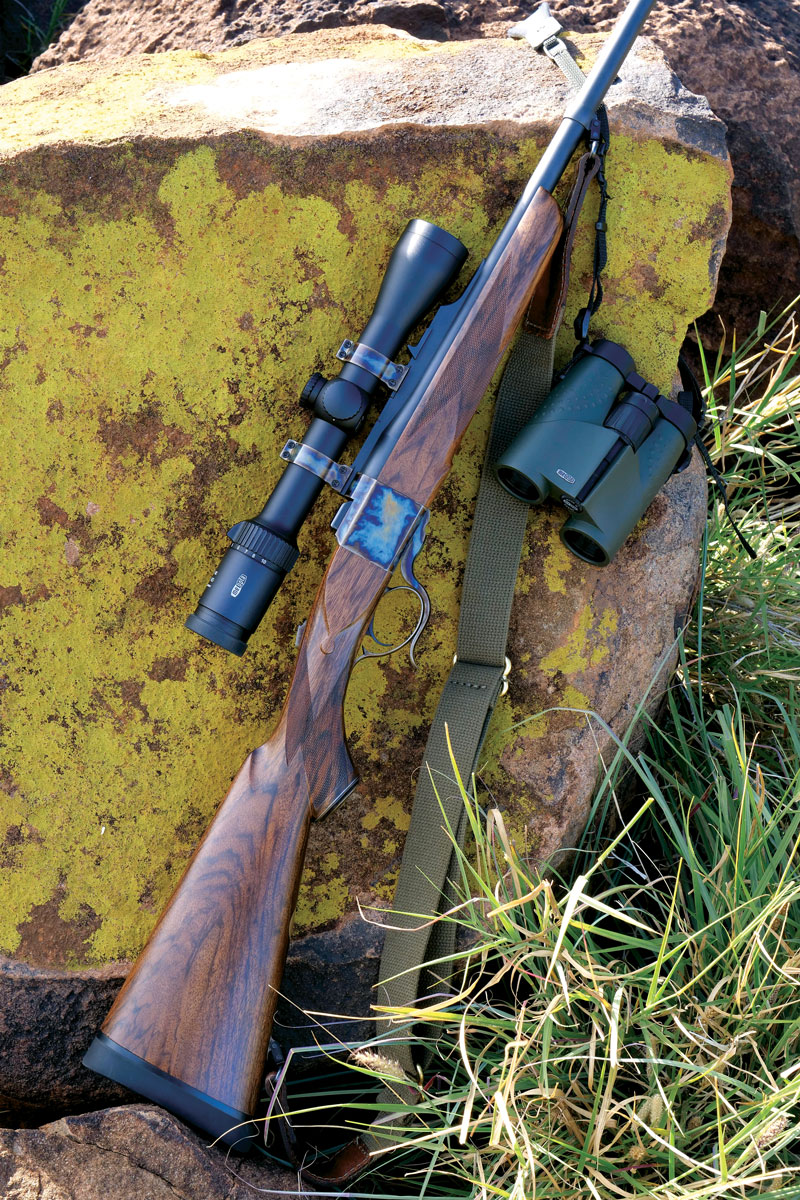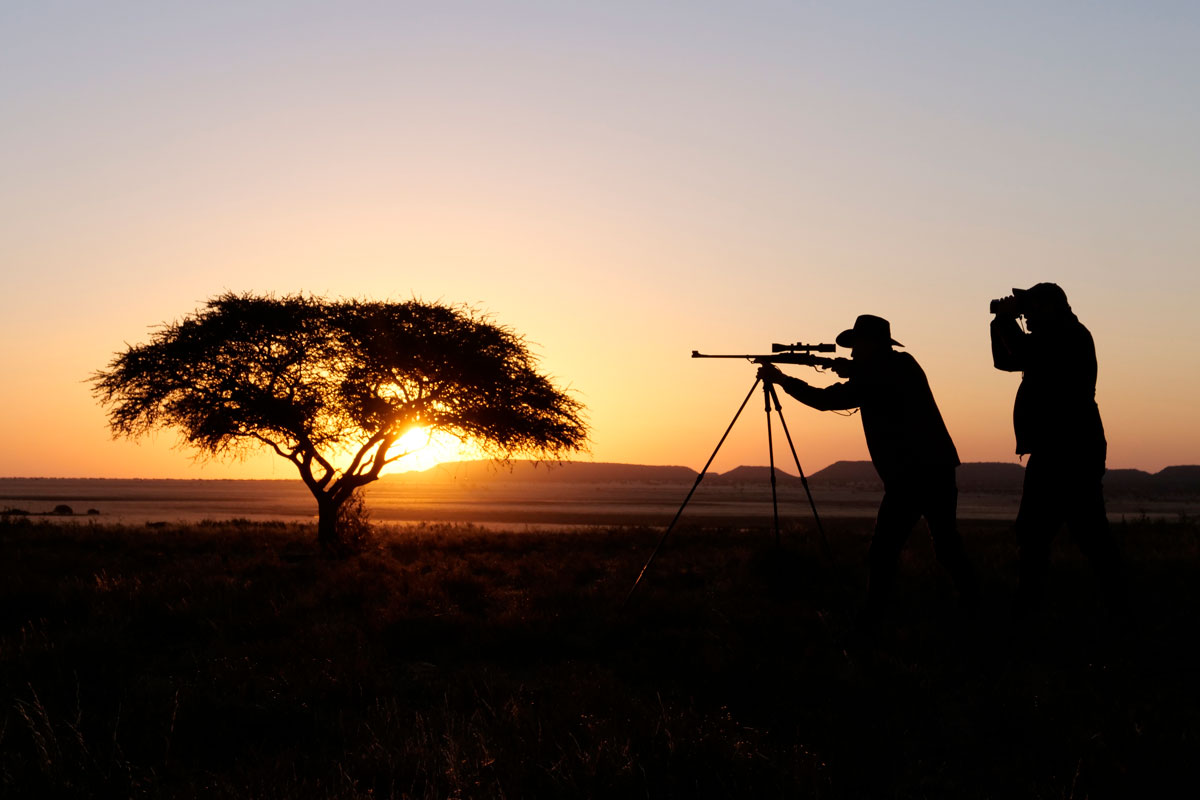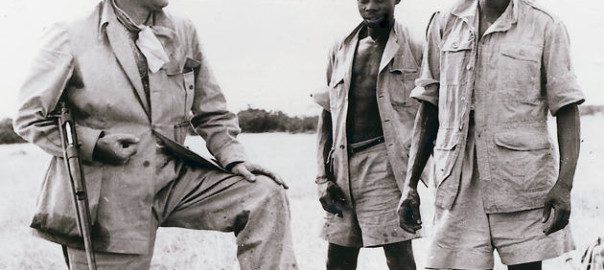The romance of the falling block single-shot rifle has never been lost on me. The courage to trust my hunts to one sometimes has been.
If you’ve ever seen that photo of Selous sitting in his camp chair beside two Kori bustards with his falling block rifle leaning nearby, you understand the romance. A hunter such as Frederick Courteney Selous could afford to risk a hunt to a one-shot rifle. If he missed, no big deal. He and his .461 Gibbs-Farquharson or Holland-Woodward .256 falling block would probably get another chance in a week or a month or a year. The rest of us, with limited time and resources, typically hedge our bets with bolt-action repeaters. That, I recently discovered, might not be necessary.

The Dakota Model 10 is what this author considers the sleekest, smoothest, prettiest and most elegant falling block rifle yet created, a refinement of the Farquharson, the Holland & Holland and the Ruger No. 1.
My single-shot fears were calmed during a safari for free-range kudu, warthogs, blesbok and steinbok with Geoffrey Wayland of Fort Richmond Safaris in South Africa’s Northern Cape province. Carlos Martinez, manager of the Dakota, Remington, Marlin and Nesika Custom Center in Sturgis, South Dakota, had brought a Dakota Model 10 Deluxe to camp. It was chambered in that most classic of classic of African small bores, the 7×57 Mauser. Carlos let me borrow it. And had a devil of a time getting it back.
“There goes a warthog,” Geoffrey said within the first hour I began hunting with him. “Smack it.”
He’d already given me carte blanche to shoot any and all warthogs, area landowners having demoted an overabundance of the rooting porcines to pest status. With no “one-tag” pressure to muddle my thinking, I aligned the horizontal reticle center mass on the fleeing pig, swept the vertical crosshair a pig-length ahead, kept swinging, and fired. The 120-grain Barnes TSX landed with a meaty whop and so did the warthog.
We were still photographing this one when a blesbok came loping toward us, dust flying from its hooves, spooked by who knew what on the grassy savanna dotted with acacias like garden umbrellas. I lifted the Dakota. The buck stopped a football field away, deep in the end zone, as if assessing the situation. The 7×57 caught him before he figured it out.

Life may be too short to hunt with an ugly gun, but ogling a too-pretty one can seriously interfere with hunting.
Only later, after photographing the rifle astride the blesbok, did I remember that I did not remember working it. Shoulder, snick the tang safety, align the Meopta reticle, and fire. No compensating for a muzzle-heavy imbalance. No feel of an oversized forend or grip. No fumbling search for the safety or trigger. No thinking about anything but sight picture, reticle on shoulder. Everything was where it should have been, performing as it should have performed. The result was a bang, dead quarry, but no perceived recoil. One could learn to appreciate this 7x57mm Mauser cartridge.
The Dakota Model 10 is what this author considers the sleekest, smoothest, prettiest and most elegant falling block rifle yet created, a refinement of the Farquharson, the Holland & Holland and the Ruger No. 1. Unlike all of them, its action is pristine, unmarred by any screw head or pin. This makes it the perfect canvas for a world-class engraver such as Jesse Kaufman.
Alas, Kaufman hadn’t laid hands on this rifle, but someone at the Custom Center had graced it with rich, swirling case-coloring as mesmerizing and almost as lively as gasoline on water. The Talley rings securing the Meopta Meostar 1.7-10×42 scope sported the same case-coloring. I could get lost in it almost as easily as my wife’s blue eyes.
This understated elegance is enhanced by a hand-rubbed, oil-finished, exhibition-grade English walnut stock with inletted Ken Howell sling stud on the butt and a barrel-band sling attachment up front.
If this rifle had been any more striking, I’d have missed seeing half the antelope on this safari. Life may be too short to hunt with an ugly gun but ogling a too-pretty one can seriously interfere with hunting.

As this cut-away shows, the Dakota Model 10’s action is pristine, unmarred by any screw head or pin.
Somehow, however, I managed to force myself to scan the acacia-studded yellow grasslands surrounding Fort Richmond headquarters. I was rewarded by the usual diversity of plains game from tiny steinbok to oversized eland. And, it occurred to me the rifle I carried was perfect for all of it. Oh, I broke free a few times to hunt with a spectacular Custom Center Marlin 1895 in 45-70 Govt., a High-Grade M700 in 280 Rem. and even a synthetic M700 SIXSITE Custom synthetic in 6.5 Creedmoor, but whenever Carlos wasn’t looking, I sneaked out with that Model 10 and didn’t return until dark.
On one of those ventures, friend and frequent Fort Richmond hunter Richard Mann led me to his favorite kudu spot atop Kudu Mountain. At sunset, just as he’d promised, a “meat bull” strolled off the vast savanna and remarkably, almost magically, walked right to us, stopping at what we estimated was 250 yards and steeply downhill.
“Should be a dead-on hold,” I said, snuggling the single-shot atop my pack lying over a rhyolite boulder. Richard concurred, so I turned the Meopta’s power from 4x to 8x and lined up on the young bull’s shoulder. The Barnes TSX bullet landed right there.
“You kind of like that single-shot, don’t you,” Richard asked as we stood by the fallen bull, it’s striped hide reflecting the evening sky.
“The caliber, too,” I replied. “I’m beginning to see what Karamojo Bell liked about this round. As for this Dakota, I think our old buddy Rob Lancelotti summed it up nicely.”
“What’d he say?”
“He said: ‘It’s not a single shot; it’s a single loader.’ And the way this thing shoots, a single load is usually enough.”




